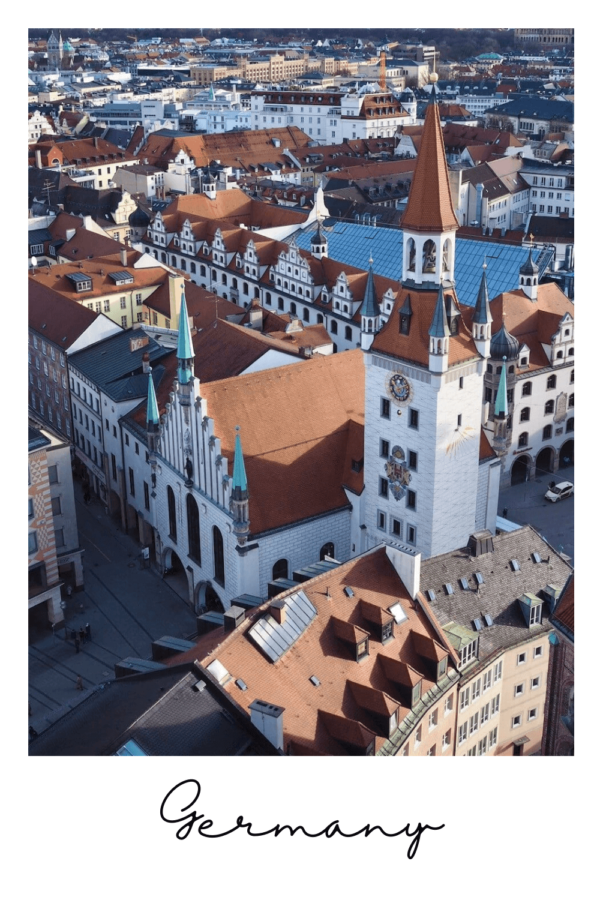The best walking tour of Nuremberg Germany
Have you been looking for the best walking tour of Nuremberg, Germany, that will let you start any time, pause in the middle and comes with a fun Australian tour guide? Look no further, you’re in the right spot!
Let me take you on a whirlwind tour of the Altstadt or old city, we’re stopping to get a fresh pretzel for breakfast from one of the many bakeries on the way.
If you’ve never had an authentic Breze as they’re called in Bavaria, this is the time to try!
And the best news of all, they come in so many different fillings. Once you’ve got your breakfast for about 2.50€ , let’s munch and explore!
Top tip: While the Brezen are delicious, I would suggest that they’re only worth eating fresh, a day-old pretzel could easily stand in for a cement rendering of a former baked good. Stale doesn’t even begin to cover it!
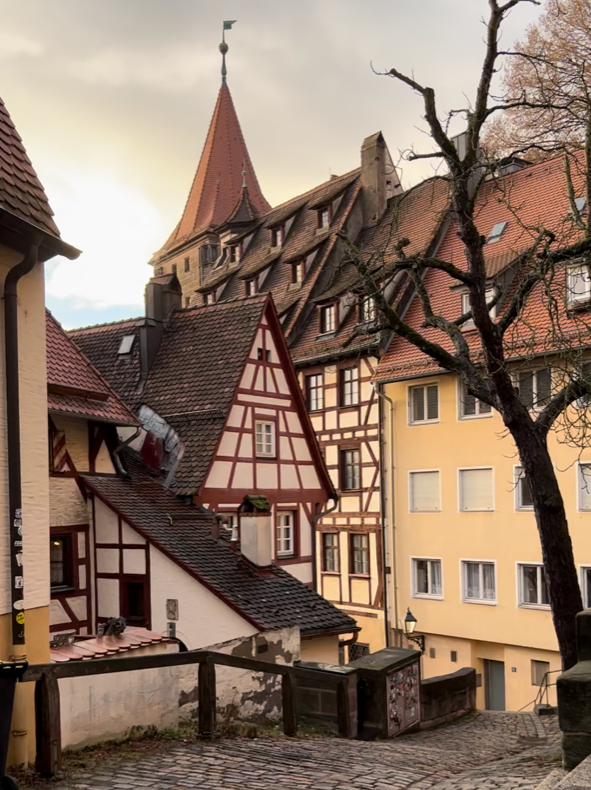
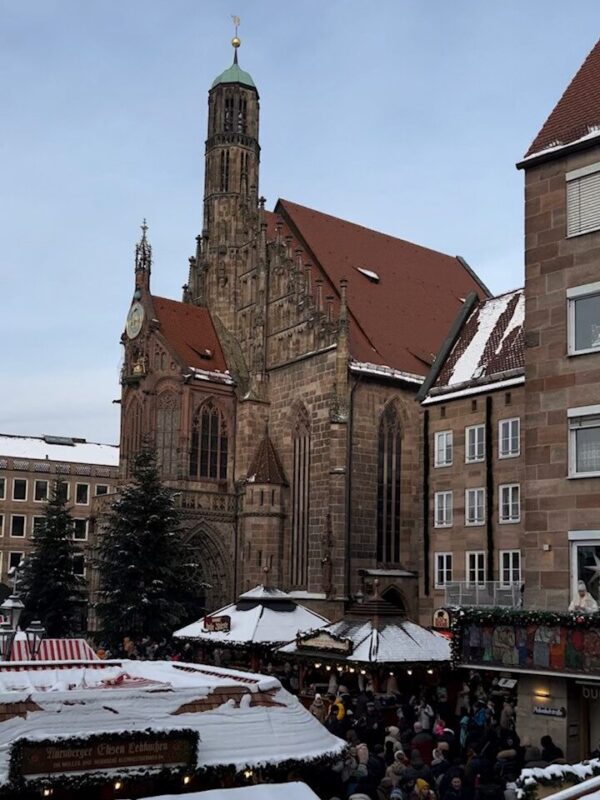
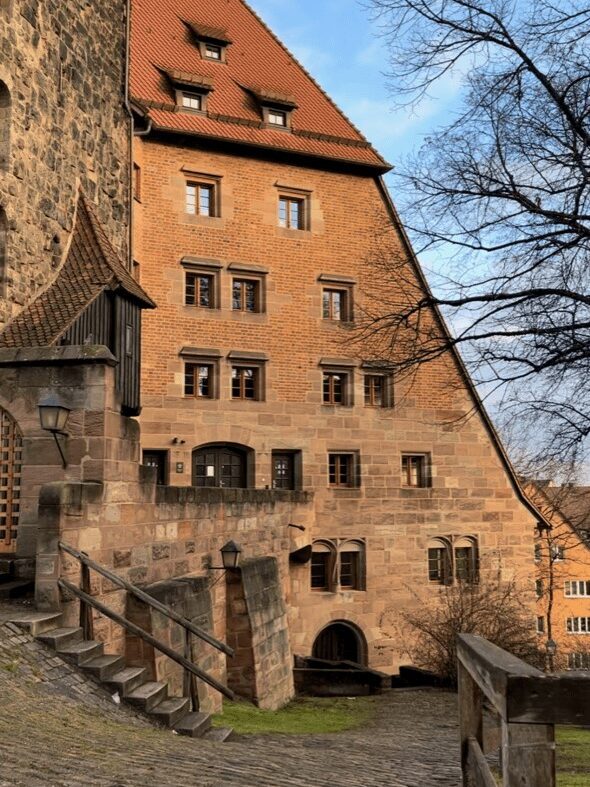
Looking for the quick version and a handy map of this walking tour of Nuremberg?
If you’re just here for a hitlist of sights you can’t miss while you’re on a walking tour of Nuremberg, Germany, I’ve got you covered! I’ve included the German names as that’s how they will appear on maps/Google.
Visiting Bavaria in time for the Wies’n? You have to check out my guide to Oktoberfest!
1. Frauentorturm
2. Handwerkerhof
3. Mauthalle
4. Lorenzkirche
5. Nassauerhaus
6. Heilig Geist Spital
7. Hauptmarkt + Christkindlesmarkt in Dec.
8. Frauenkirche
9. Schöner Brunnen
10. Bratwursthäusle be St Sebald
11. Sebalduskirche
12. Altes Rathaus
13. Kaiserstallung (former Imperial stables, now a hostel)
14. Fünfeckturm
15. Kaiserberg (Sinwellturm, terrace, main palace)
16. Pilatushaus
17. Tiergärtnertor
18. Albrecht Dürer Haus (and hare statue)
19. Weißgerbergasse
20. Henkersteg + Weinstadel
21. Trödelmarkt
Bonus sights
22. Weißer Turm
23. Elisabethkirche
24. Jakobskirche
I’ve gone into more detail on each of these sights and added some walking directions in the next sections coming up!
From the Frauentorturm to the Heilig-Geist-Spital
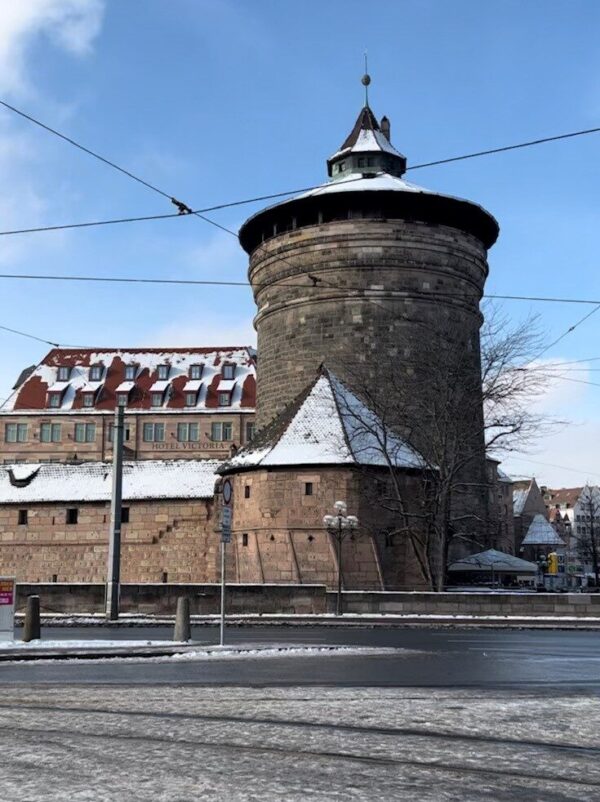
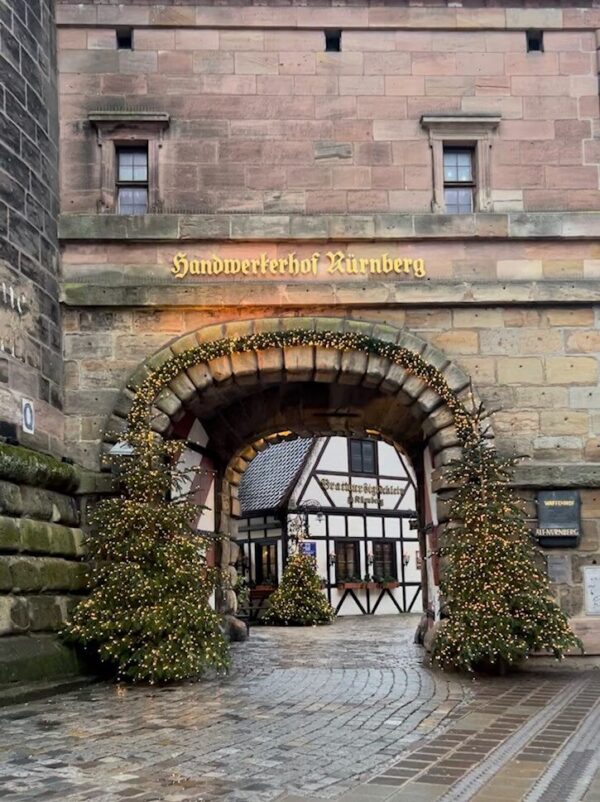
First off, we start closest to the main railway station, the entry point for most visitors to the city.
Directly in front of you is the circular Frauentorturm or Ladies Gate Tower. A convent used to sit just slightly north from this gate, hence the name.
Dating from roughly 1386, this has been the welcoming sign to Nuremberg for quite a while. If you’re arriving via train or bus, this will likely be your first view of the old town too!
And tucked just next to it is the Handwerkerhof, a quaint replica of the little handicraft shops that were common here during the Middle Ages.
If you’re not lucky enough to be here for the Christmas markets, this is intended to be a similar vibe and the shops here all sell handmade souvenirs for you to take home.
Continuing down Koenigstrasse, you’ll pass the restored Mauthalle (Grain Hall) to your left.
This used to be a grain storage facility, built in 1498, to hold food in case of a famine or siege on the city. Have a look at the ornate roof, faithfully reconstructed after damage in the Second World War, you can count the windows of its five stories.
Now onto the towering Lorenzkirche, you can’t miss this enormous cathedral to your right.
Originally built in the 13th century, it was almost totally destroyed in WWII and lovingly reconstructed in its full Gothic glory.
Ornate sculptures and art adorn the walls inside and admission is totally free, go in and wander around at your leisure.
Even if you’re not that into religious artefacts, the life-size Angelic Salutation hanging from the roof via a metal chain (you’ll know the one) and a 25 metre high, carved tabernacle will amaze you.
Continue down to the town square, stopping at the Museum Brücke (Museum bridge) for a fairytale view of the Heilig Geist Spital (Holy Ghost Hospital) sitting pride of place over the river.
Featured on many a Nuremberg postcard, this building was originally built in 1339 to house the elderly and sick residents of the town.
And it’s still a senior citizens’ home today with a separate traditional restaurant and pharmacy which still runs. So if you need some cough drops, just pop in.
The history just in this building is mindboggling. Once you’ve got some pretty snaps of the building stretched out over the water, let’s continue on our walking tour of Nuremberg, Germany.
Don’t miss the Naussauer House on the opposite corner as you exit the church, the tower was the office of imperial clerks in the former empire and features an interesting sundial.
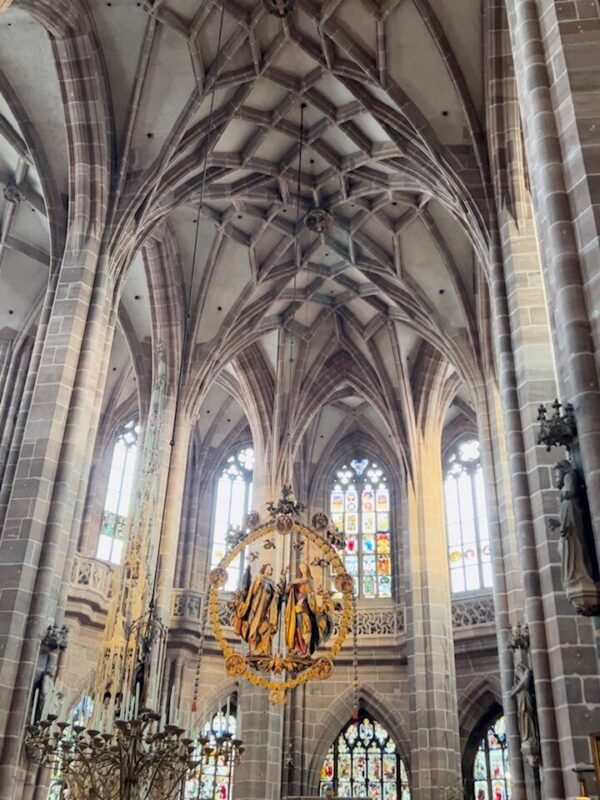
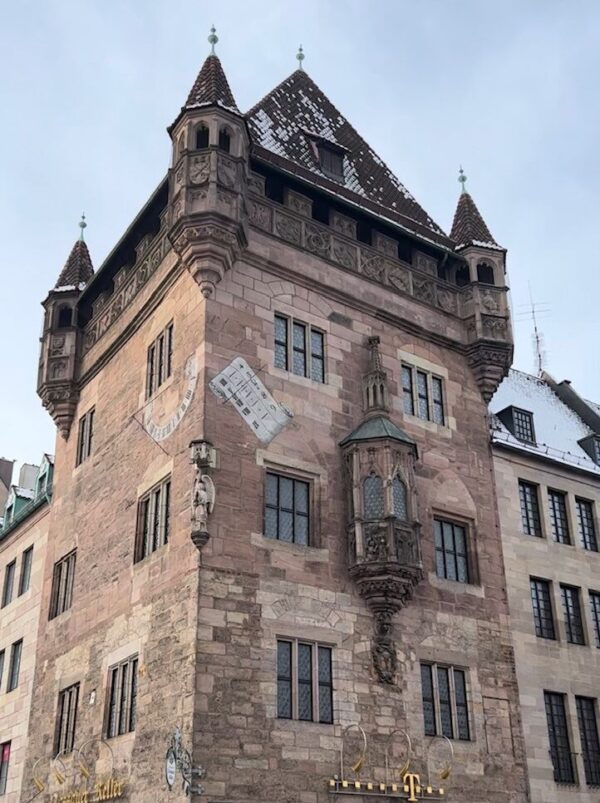

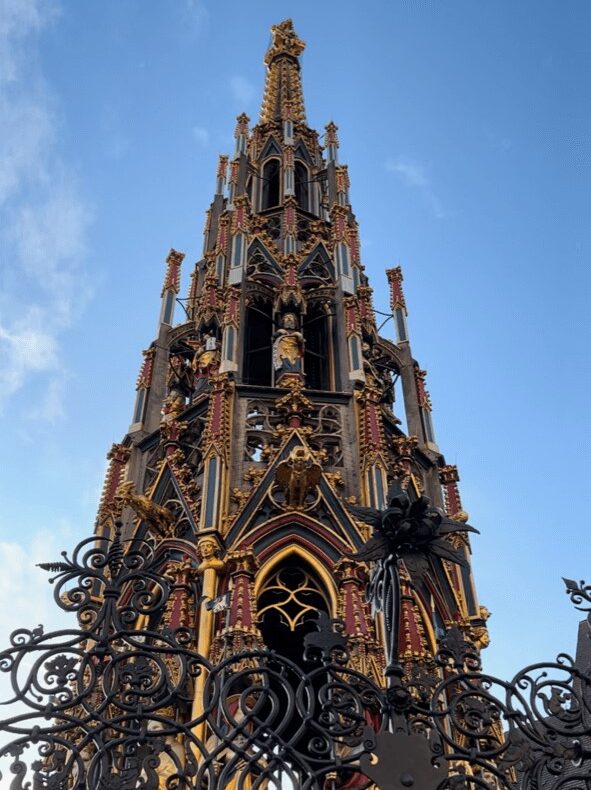
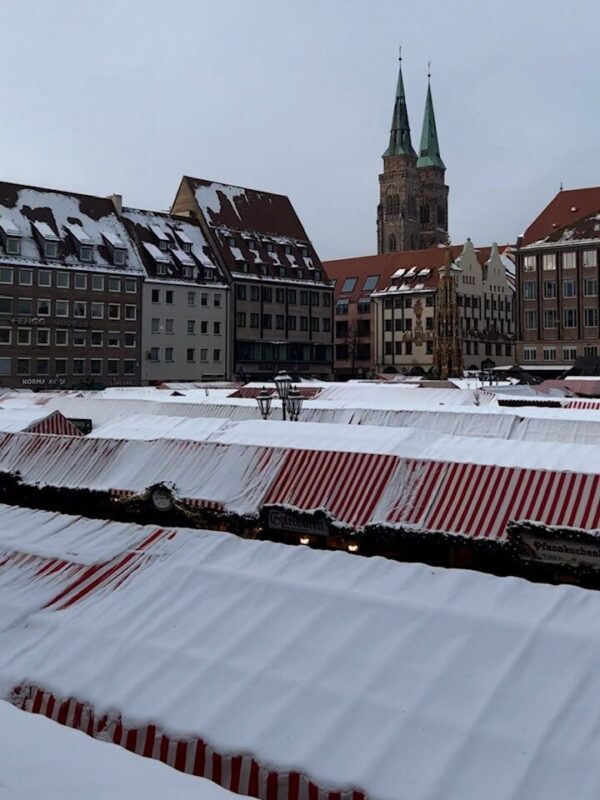
Off to the main square and a stop for bratwurst
Now it’s time for the heavy hitters, trot down the hill to the Hauptmarkt (town square).
This gigantic space houses the aforementioned Christkindlesmarkt in December.
If you’re not here for the winter festivities, admire the sheer size of the space and then consider it all filled with stalls selling Christmas decorations and some chilly tourists!
Stop to observe the grand townhouses lining the square and the dominant Frauenkirche (Church of Our Lady) standing proud above it all.
Another gothic stunner, it’s closed for the summer of 2023 to allow for renovations but hopefully will be back open again soon.
Spy the ornate clock high on the façade of the Frauenkirche, at midday the doors open and there is a little procession around the Holy Roman Emperor shown on the clock.
Cross the square and stop by the glistening Schöner Brunnen (beautiful fountain), spinning the rings attached to the railing is meant to bring good luck!
Debate rages about whether tourists should spin the iron or the gold ring to bring that good fortune…
If you’re all churched out by this point, you should swing into the famous Bratwursthäusle bei St. Sebald, you’ll be able to smell it from afar!
The perfect spot to try the Nürnberger Rostbratwurst, mini grilled sausages flavoured with marjoram, traditionally served in threes in a bread roll (“Weggla” in the local dialect).
The gigantic church called Sebalduskirche, dedicated to the patron saint of Nuremberg, is just behind it. Admission is free here as well and there are more medieval masterpieces inside.
Attending the Yuletide celebrations? I’ve got just the guide for you on your winter visit to Nuremberg.


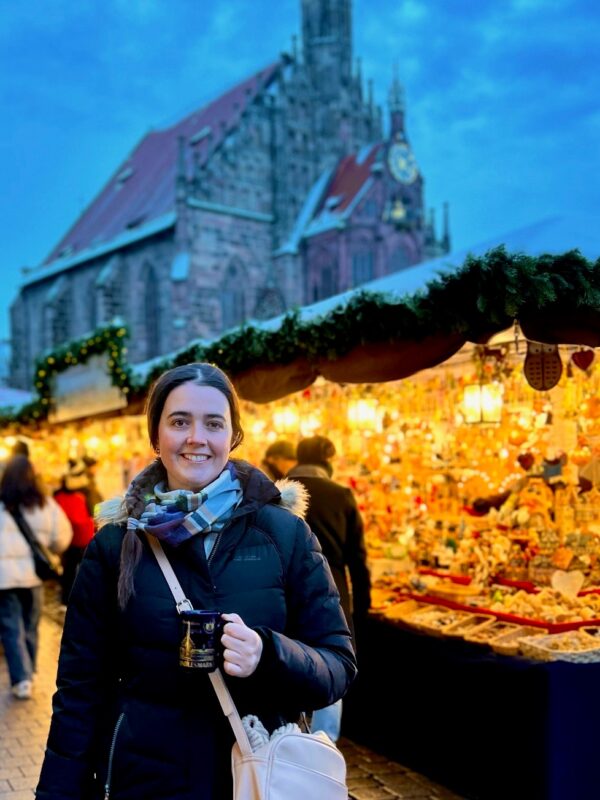
The shrine of St Sebaldus is said to contain relics of the saint and is a gilded casket covered by darker, finely worked bronze, head all the way to the far end of the church from the main entrance.
It was absolutely ice cold when I stopped by this church, possibly even colder than the -2 degrees Celsius outside, which was kinda impressive.
If you’re visiting in the cooler months, make sure that you bring a coat!
Personally, I spread the church visits over two days to ensure I gave them proper attention.
At 798 years old for St. Sebald’s and St. Lorenz’s 773, they’ve got some serious history in these walls. The Frauenkirche is the baby of the group, only 662 years old!
Ready for a hike?
Your next stop requires a bit of walking, plot your course to the Kaiserburg and get ready to burn off the bratwurst.
Known in English as the Imperial Castle, it’s comprised of numerous towers, buildings and gardens within a walled fortress.
On your way up, you’ll pass the former stables (Kaiserstallung), now converted into a youth hostel, the Fünfeckturm (Pentagonal Tower) is attached to the end.
Step out onto the enormous terrace and admire the sweeping views back over the city and all its landmarks.
See if you can pick out the cathedrals that you stopped into earlier. Once you’ve recovered from the hike up, head inside to the castle courtyard.
Tickets can be bought on site at the office, the combo ticket including the Palace with Imperial Museum, Deep Well and Sinwell Tower access is 7€, you can double check the different options online.
The permanent exhibition displays the story of the castle from medieval beginnings in 1050 through to almost complete destruction by 1945 due to WWII. Thankfully they were faithfully restored after the war.
The Deep Well is over 50 metres deep and provided essential water supplies within the fortress, you can imagine invading forces are unlikely to let you pop out to the river as needed.
If you’ve still got the puff, the combo ticket also allows you to climb the Sinwell Tower for an even higher view over the city.
From such a commanding viewpoint, soldiers could see enemy forces approaching from afar and raise the alarm.
In total, if you’re planning to see all the attractions at the fortress, I would give it 3-4 hours. If you’re super keen on the Holy Roman Empire, of course you might like longer here!

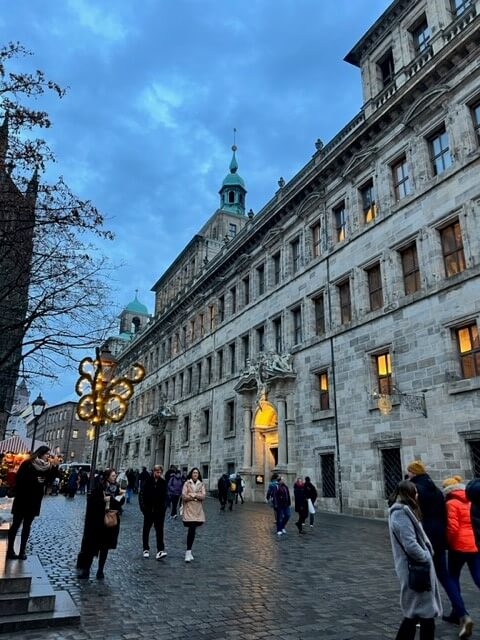
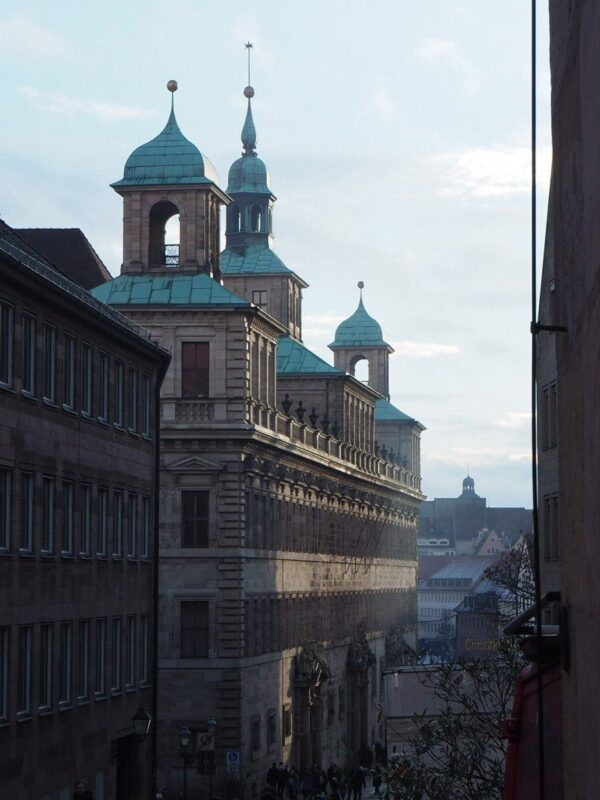
Top tip: If you’re looking to stick to your budget, seeing the city from the beautiful fortress terrace and wandering around the fortress grounds are totally free! You only need a ticket if you’d like to see inside the buildings.

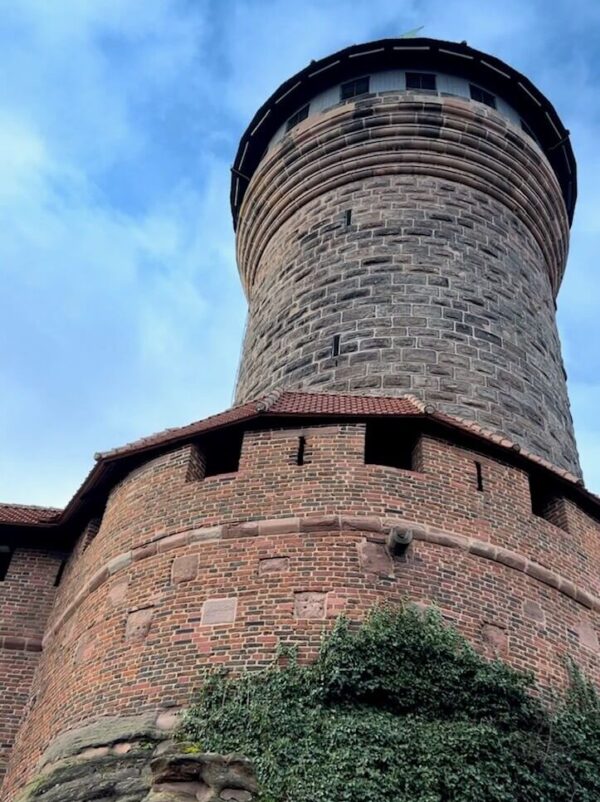
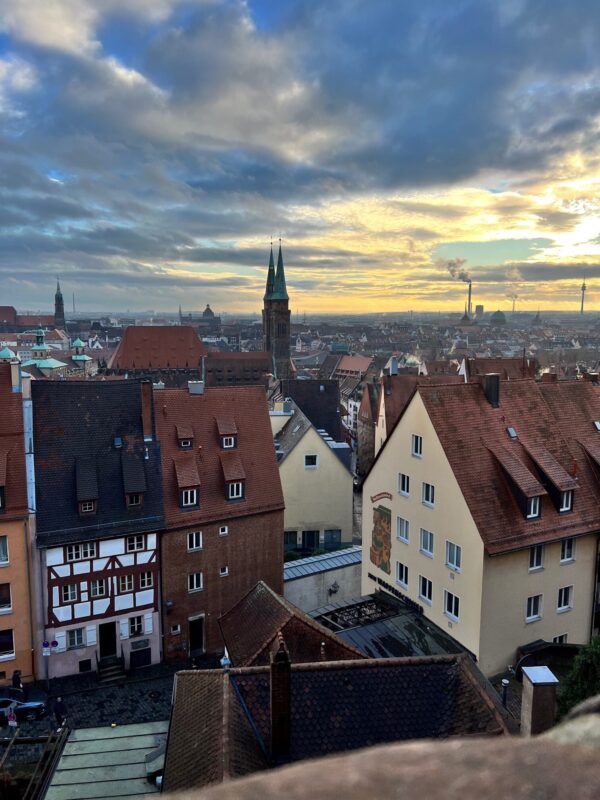
Back down to Nuremberg’s Altstadt
Since you’ve probably worked up an appetite with all that sightseeing, wander beneath the fortress walls along Am Olberg, this will bring you out at the Pilatushaus.
The knight peering down at you from the corner of the house is St. George, the patron saint of knights.
The house was originally constructed in 1489 and housed a famous armourer, hence his homage to St. George.
Walking further into the Tiergärtnertorplatz square, this charming little spot features the work of one of Nuremberg’s most famous sons, the artist Albrecht Dürer.
He was a friend to Raphael and Leonardo da Vinci, famous for his paintings and woodcut prints.
His former residence (Albrecht Dürer Haus) stands on the southern corner of the square and is now a museum dedicated to his work, just look for the red framework.
A statue referring to one of Dürer’s most well-known paintings, the Young Hare (1502), is also in the square, just look for the giant rabbit!
If you’re ready for some food, Zum Albrecht Dürer Haus is a restaurant nearby serving traditional Franconian fare or stop into the Café am Dürerhaus just across the square if you’re visiting in nice weather.
The Tiergärtnertor city gate and its accompanying tower can be climbed for a beautiful view back over the old town, it’s named for a game reserve that used to be beyond the walls.
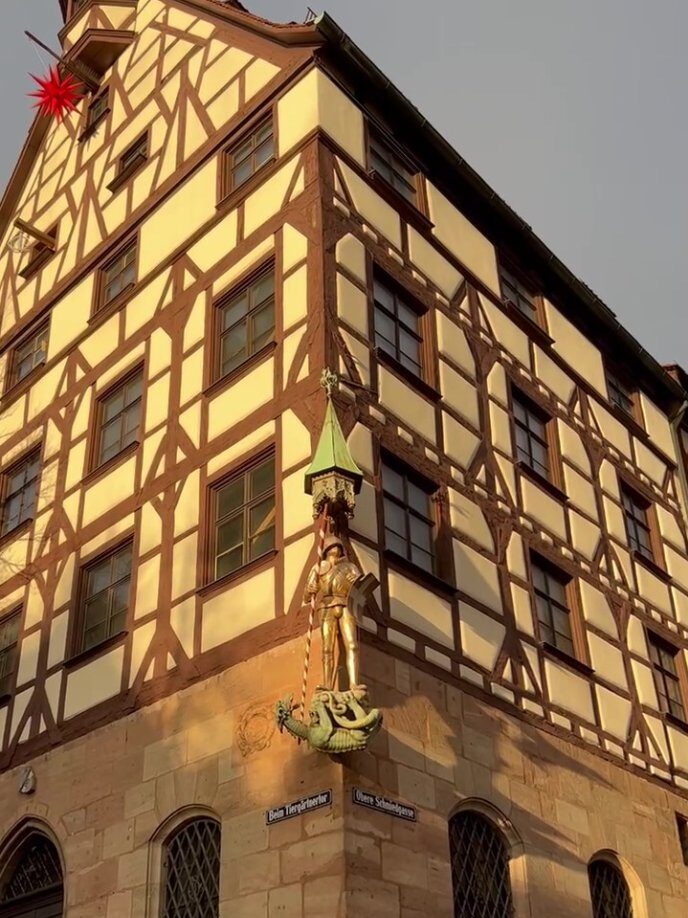
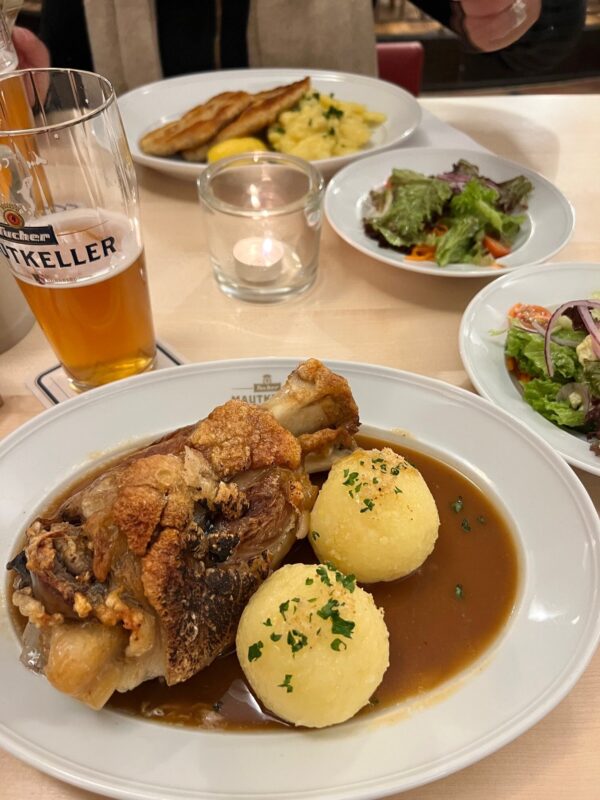
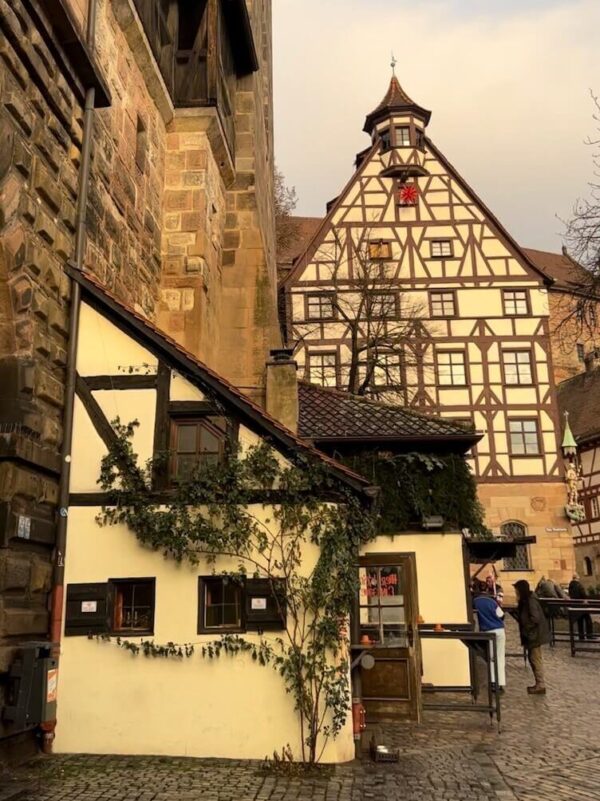
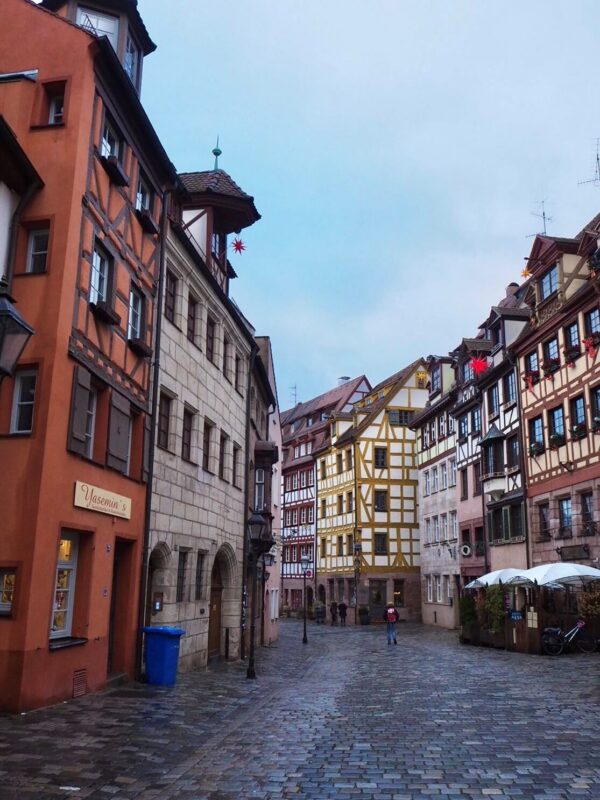
A street just begging for its close up
Once you’re feeling refreshed and refuelled, we’re headed further into the old town for perhaps the prettiest part of this imperial city.
We’re literally on the downhill run of our walking tour of Nuremberg, Germany.
Head down Albrecht-Dürer-Strasse (I did say he’s Nuremberg’s favourite son) and turn right onto Weinmarkt, veering left onto the stunning Weißgerbergasse.
Formerly home to the Imperial City’s tanners, these colourful half-timbered houses are one of the hallmarks from the “Golden Age” when the city was at its richest.
Mostly avoiding the bombs of WWII, it’s easily distinguished from the neighbouring streets which weren’t so fortunate.
Take your time wandering up and down the street, stop at number 8 for the most lavishly decorated house, formerly a master painter’s residence.
Top tip: If you’re in need of caffeine for the final leg of the walking tour, you can stop by the BERGBRAND Kaffeerösterei for your daily kaffee and kuchen fix (German for coffee and cake). The German answer to afternoon tea!

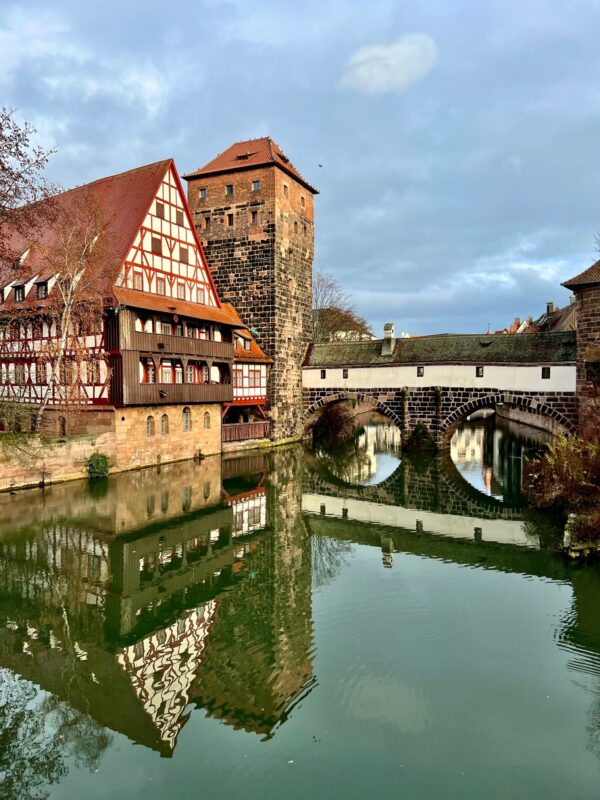
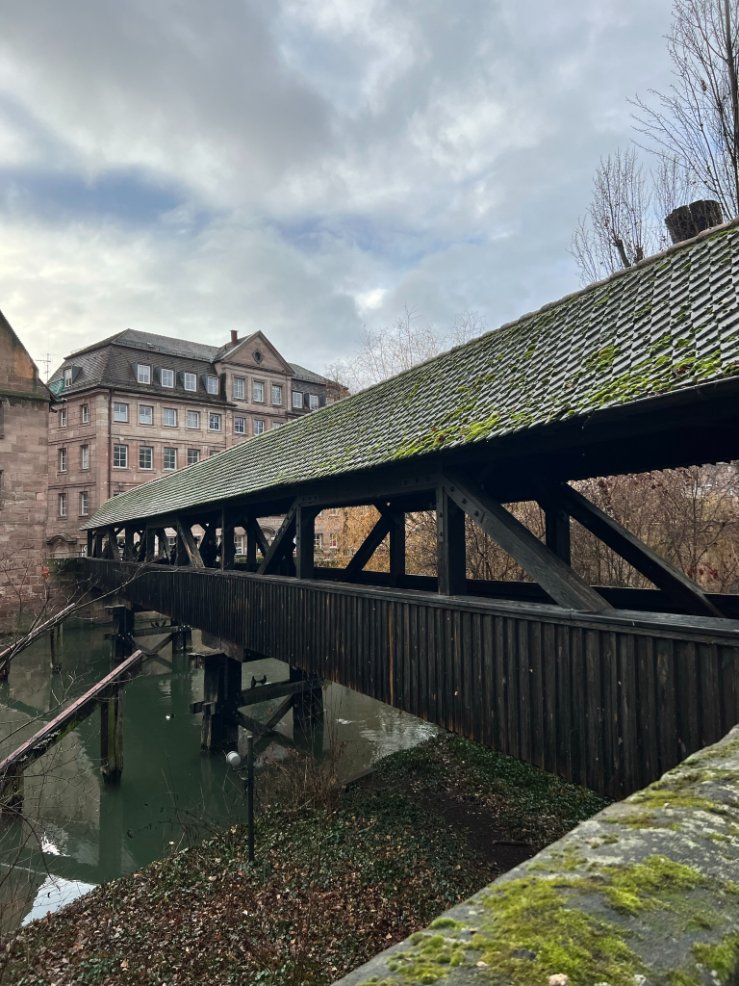
Heading to the Hangman’s House
Turning left at the end of Weißgerbergasse onto Maxplatz, then right onto Maxbrücke, stop in the middle of the bridge.
You’re now looking at the quirky Henkersteg and the former hangman’s mini house perched on the bridge.
The unfortunate executioners, although an essential part of law and order in the city, were deemed too dishonourable to live within the bounds of the city walls during the Middle Ages.
Therefore they, and their respective families, were made to live in this tiny cottage dangling over the Pegnitz, far from contact with the upstanding citizens of the city. I suppose unless they were executing them!
The half timbered hall to the left of the Hangman’s Bridge is the Weinstadel or wine store.
Formerly a storehouse for the vast quantities of wine and at times, provided accommodation for the poorer residents of the city.
It’s now been converted into student accommodation for one of the local universities, my student digs were certainly less picturesque.
Get some happy snaps of the bridge and weeping willows from Maxbrücke and don’t forget to admire the view in the other direction.
Once you’re photographically satisfied, cross over the Henkersteg and onto the charming Trödelmarkt island.
This used to be a flea market, directly translated a junk island, but now hosts some charming houses and shops.
Feel free to end your walking tour here in one of the cafes or restaurants along the river, I’ve heard good things about Trödelstuben.
Keen for more medieval magic? Take a look at my ultimate guide to Nuremberg

Keen for one more tower?
If you’re still keen for more, I’ve got one more spot for you to see.
Head down Hintere Ledergasse and follow it all the way to Ludwigsplatz, the gigantic tower right in front of you is known as the Weißer Turm (White Tower).
It used to be a part of the city walls way back in the Middle Ages but is now the entrance to a subway station beneath the square.
Originally covered in white plaster, it was stripped back to the sandstone during repair work in the 1950s. Hence the name which now doesn’t make much sense!
You’ll find the domed St. Elizabeth and plainer St. Jakob’s churches further along the square, if you’ve still got the puff for extra church viewing, feel free to go inside.
Both churches were damaged during the Second World War, St Jakob’s is quite austere inside while St Elizabeth’s is more ornate.
All good things must come to an end
The whole walking tour covers around 4km in distance with a decent uphill section to the fortress, I would recommend breaking it up over 2-3 days if you have the luxury of sufficient time in Nuremberg.
Personally I would cover up to the fortress for one day and save the second half of the walking tour for another day.
Nuremberg is at its most charming when you have time to meander past the beautiful old houses and soak up the history, rather than racing to the next sight on the map.
Regardless of how long you’re in Nuremberg for, it’s sure to leave you wanting more. So much history in one stunning city!
I hope you enjoyed this (virtual) walking tour of Nuremberg, Germany
I hope you’ve had a lovely time wandering amongst the half-timbered houses and snapped lots of postcard pictures for memories later on.
And you’re getting an appetite for more delicious Franconian food, Elisen Lebkuchen (specialty gingerbread) is always a good idea when roaming the city.
If you enjoyed this walking tour of Nuremberg, Germany, pin it so you can use it later on

